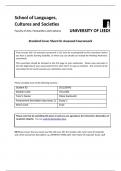School of Languages,
Cultures and Societies
Faculty of Arts, Humanities and Cultures
Standard Cover Sheet for Assessed Coursework
From January 2017 all assessed coursework in LCS must be accompanied by this coversheet (unless
you have a specific learning disability, in which case you should use instead the Marking Awareness
coversheet).
This coversheet should be included as the first page of your submission. Please copy and paste it
into the beginning of your assessment (Ctrl+A, then Ctrl+C to copy its entirety). The contents of the
coversheet do not count towards your submission word count.
Please complete each of the following sections:-
Student ID: 201226943
Module Code: ITAL2301
Tutor’s Name: Olivia Santovetti
Assessment description (eg essay 1): Essay 1
Word count 2122
Please note that by submitting this piece of work you are agreeing to the University’s Declaration of
Academic Integrity. You can read the Declaration here.
NB Please ensure that you name your file with your SID, the module code, tutor name (if required)
and a brief assessment description e.g. 200987654 MODL1234 Tutor Name (if required) Essay 1.pdf
, ‘In order to found a nationality, it is necessary that the feeling and
consciousness of a nationality should exist.’ (Giuseppe Mazzini, Life and
Writings). In the light of Mazzini’s words, discuss the way in which ANY TWO
of the texts you have studied contribute to the foundation of an Italian
nationality.
The 19th Century saw the rebirth of national sentiments and the creation of a united
Italy. Mazzini was one of the leading figures in this political and cultural revolution;
however, many important literary figures of the time encapsulated this national
sentiment in their works to further progress the notion of Italian unity. Two texts
which contributed to the foundation of an Italian nationality were All’Italia by
Leopardi, written in 1818 and Al Quarto al Volturno: Notorelle d’uno dei mille by
Abba, written in 1881. Each text was written in a different context and portrays the
theme of nationalism using varying methods. Both these authors were part of the
Romantic Nationalist movement in Italy with Mazzini as the leading figure of this and
therefore nationality is a strong theme with runs throughout their works.
Leopardi was one of the pre-unification romantic nationalist and patriotic figures
whose works contained strong themes and ideals based on Italian society. All’Italia
in particular is one of his Canti which contributed to the foundation of Italian
nationality by creating a sense of nostalgia and using the contrast between the past
and present to inspire Italians to unite and recreate a strong nation. The first
example of this is, ‘o patria mia, vedo le mura e gli archi, e le colonne e i simulacri e
l’erme, torri degli avi nostri’.1 Leopardi hereby highlights the strength of the old
Roman regime, by using the physical proof of its remains to emphasise its previous
power. The remains of Italy described are objects which represent the vitality of Italy
as well as its previous stability, safety and security and therefore emphasising the
fact that this is no longer representative of Italy. The situation in Italy which triggered
this nostalgic sentiment was the fact that in 1814 the Napoleonic dictatorship came
to an end and the Congress of Vienna which followed, divided Italy and large areas
came under foreign control. This exacerbated Leopardi’s longing for Italy to regain its
independence and image as a powerful state, consequently triggering his motivation
to encourage a nationalist sentiment amongst Italians to achieve this.
This past strength depicted by Leopardi is a stark contrast with his description of
Italy’s current situation. One characterised by ‘ferite’, ‘sangue’, and a country
‘negletta e sconsolata’, ‘che di catene ha carche ambe le braccia’, having fallen ‘da
tanta altezza in così baso loco’.2 In this portrayal of Italy’s present, defeated state,
Leopardi compares Italy to a weak and defeated woman who is subordinate and a
victim to those who control her. As Galassi states, ‘the women of Leopardi’s poetry
1
Giacomo Leopardi, ‘All’Italia’, in G. Leopardi, Canti , translated and annotated by J. Galassi
(London: Penguin, 2010), p.2.
2
Giacomo Leopardi, ‘All’Italia’, p.2/4




